HGST Deskstar NAS 4 TB Review
by Ganesh T S on November 22, 2014 2:00 PM ESTRAID-5 Benchmarking - Miscellaneous Aspects
Consumers are rightly worried about RAID rebuilds and the scope for drive failures during that process. As one of our evaluation aspects, we randomly yanked out a disk during operation and cleaned it up for rebuild. We recorded the resync duration (time taken to rebuild a 3-disk RAID-5 volume when one of the disks needs to be replaced) as well as the average power consumption during that process. The two aspects, considered together, give an idea of the efficiency of the hard drive. The graph below presents the total energy consumption (Resync Power Consumption (W) X Resync Duration (s)) for the resync.
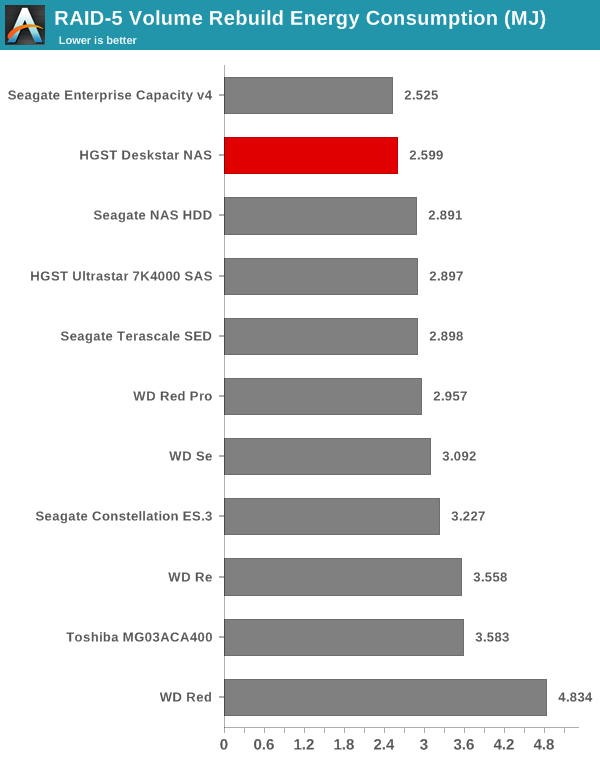
While the energy consumption aspect provides a consolidated view of the various factors, it is still worthwhile to look at the power consumption and resync duration numbers separately. The table below provides the raw information behind the above graph. The HGST Deskstar NAS is not the most power efficient, but makes up for the higher power consumption by getting the job done much faster than the drives with better power numbers.
| RAID-5 Resync Power Consumption & Duration | ||
| Drive | Power (W) | Duration (s) |
| HGST Deskstar NAS | 100.25 | 25922 |
| WD Red | 87.7 | 55125 |
| WD Red Pro | 102.72 | 28787 |
| Toshiba MG03ACA400 | 99.84 | 35886 |
| WD Se | 102.07 | 30293 |
| Seagate Enterprise Capacity v4 | 98.38 | 25670 |
| Seagate NAS HDD | 92.82 | 31149 |
| Seagate Terascale SED | 92.8 | 31230 |
| WD Re | 102.09 | 34850 |
| Seagate Constellation ES.3 | 102.37 | 31520 |
| HGST Ultrastar 7K4000 SAS | 98.35 | 29456 |
We also measured power consumption during the last stage of our multi-client test. With 25 different clients simultaneously stressing the NAS with different types of workloads, we recorded the power consumption at the wall for the NAS as a whole. The various numbers are presented in the graphs below.
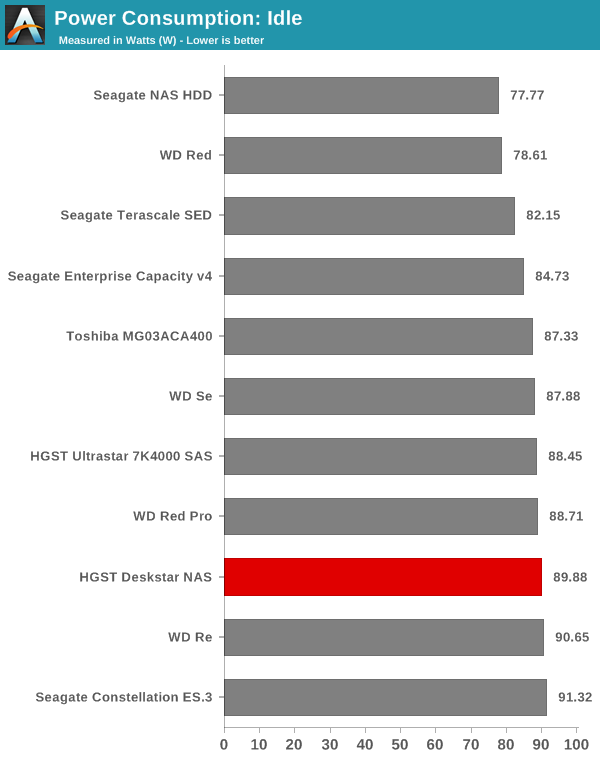
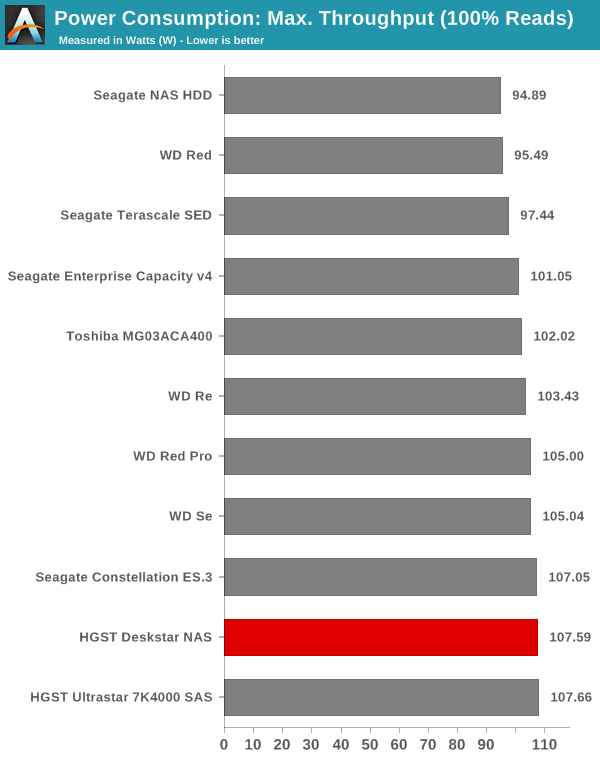
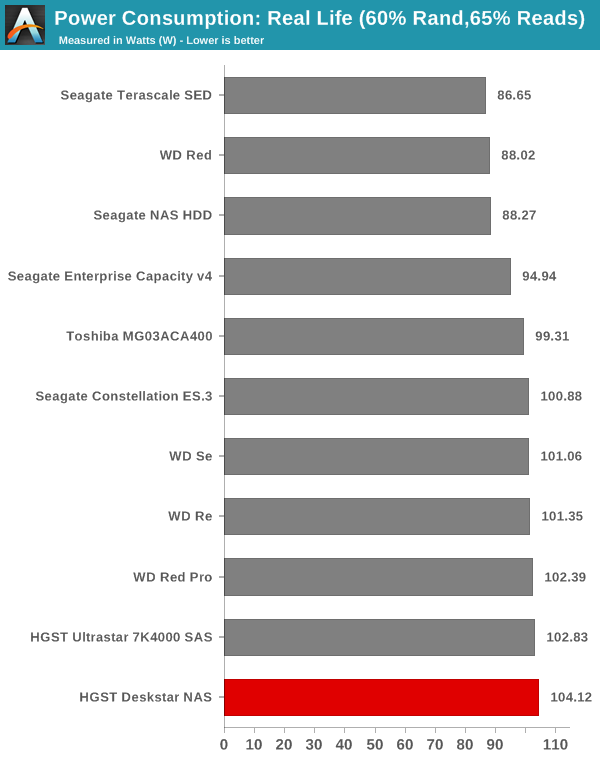
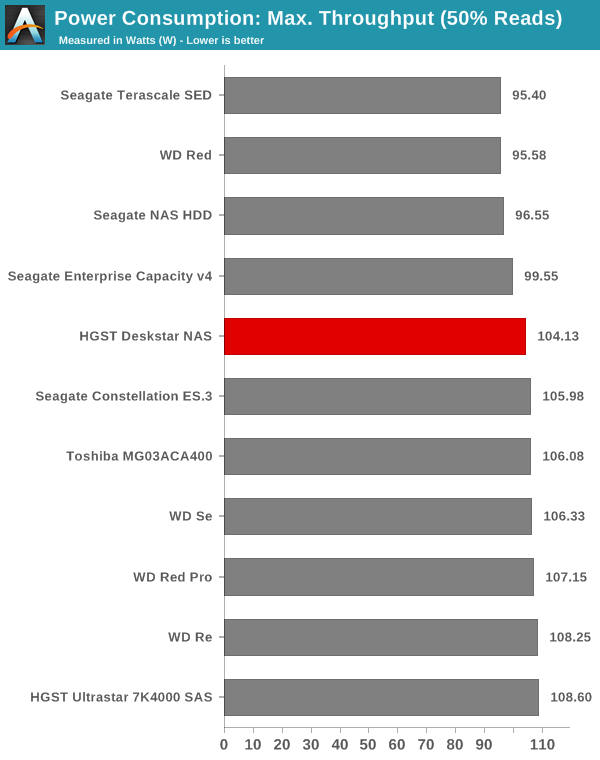
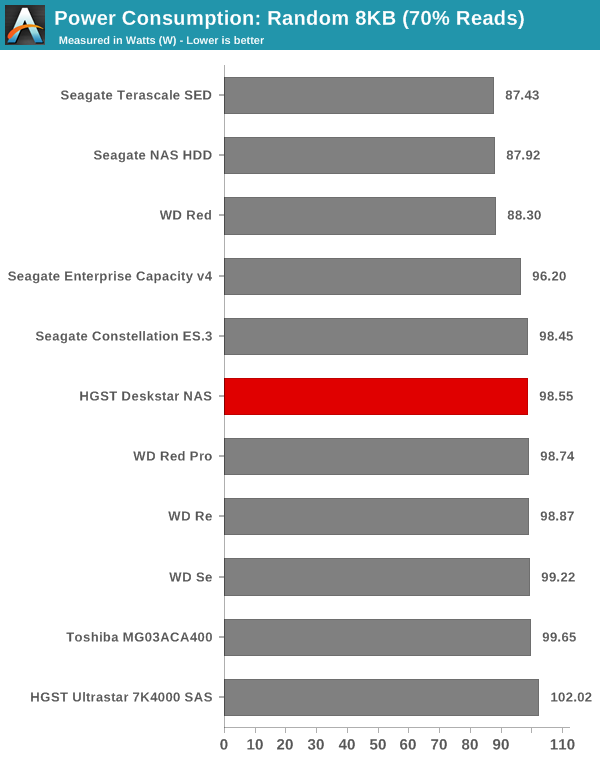
As expected, the units providing better performance have higher power consumption numbers. The HGST Deskstar NAS could be a bit more power efficient, particularly since units such as the Seagate Enterprise Capacity v4 manage to deliver similar / better performance with a better power consumption profile.










39 Comments
View All Comments
abhaxus - Sunday, November 23, 2014 - link
According to WD, the Red Pro is rated at 1 in 10^15 not 10^14 before URE. Are you working from some other data or is your comparison chart inaccurate? Planning on purchasing several drives in the next few weeks and that was going to be the key factor in my decision.ganeshts - Sunday, November 23, 2014 - link
Thanks for bringing this to my attention.When the WD Red Pro was launched, the datasheet had URE < 10 in 10^15, which I had denoted as 1 in 10^14 in our initial review. Backed up by a third-party post on another forum here: http://www.techpowerup.com/forums/threads/western-...
It looks like WD has fixed this 'error' in their latest datasheet. I will update the table shortly.
abhaxus - Monday, November 24, 2014 - link
I do remember that from their launch now that you mention it. Still torn about my purchase.Julian Boolean - Saturday, December 5, 2015 - link
Fact : As of Today (Dec 5th 2015) the Western Digital Spec Sheet for The Red Pro STILL lists the URE rate as 10 in 10^15. It is not "a mistake in the specs sheet". It has been listed that way since product launch and has never been corrected. 1 in 10^14 = 10 in 10^15. This is a 1 in 10^14 drive. I called WD myself to confirm this. Three days later I got the answer I suspected all along. It IS 10 in 10^15 ( which equals 1 in 10^14). This is just clever marketing, and it irks me to no end that countless review sites such as this have incorrectly listed the URE rates.I cannot tell you how many review sites have made the mistake of listing it as 1 in 10^15.
jota83 - Monday, November 24, 2014 - link
Read throughly the backblaze report on reliability of hard-disks, as pointed out above. HGST (former hitachi) build very robust hard disks, and they deal with vibration pretty good. Thats one of the factors (not sure if mentioned in the article) that the NAS deskstar incorporates,and which could be rated as "enterprise only".Mikemk - Sunday, November 23, 2014 - link
I'd like to see http://www.newegg.com/Product/Product.aspx?Item=N8... reviewedAbRASiON - Sunday, November 23, 2014 - link
7200rpm? Sorry but as far as I'm concerned, that's not a NAS drive. Nope nope nope nope and nope. Too hot, too noisy, silly - just silly design choice.Daiz - Sunday, November 23, 2014 - link
hmm, you might want to tell the likes of HP about that since they let you stuff their NAS appliances with up to 15k RPM drives. Not all NAS appliances sit in your living room ;)MikeMurphy - Sunday, November 23, 2014 - link
Reliability of HDDs has become a huge problem. I bought this drive as it's apparently the most reliable consumer mechanical drive out there. I was hoping there would be some commentary on this.NoSoMo - Monday, November 24, 2014 - link
Anyone interested in HDDs and their reliability should check this article out...https://www.backblaze.com/blog/hard-drive-reliabil...